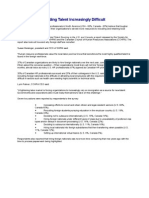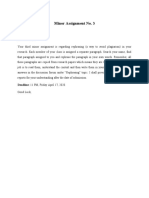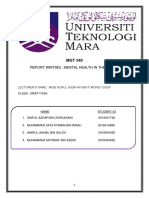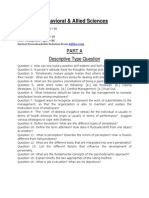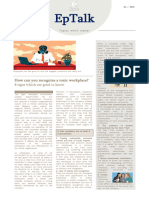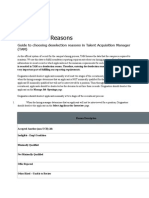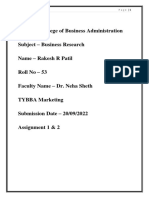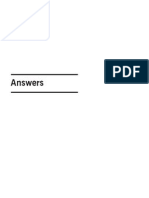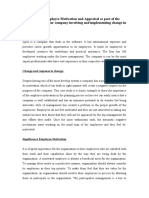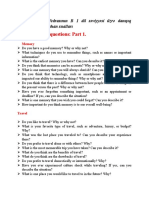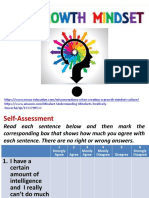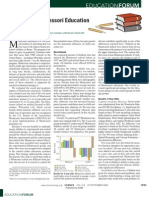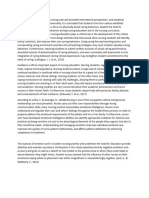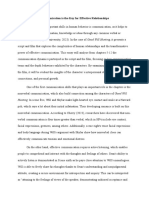Business Communication
MBA-HR Semester: I
Communication Assessment File
HR People: The Peace Makers (Write an Article Handwritten or Print-out 250 words minimum length less than of 500 words).
&
Printouts of the slides of the Presentation submitted.
Submitted to: Parveen Kumar Lecturer Business Communication
Submitted by: Mansi Verma
AMITY UNIVERSITY
UTTAR PRADSH 2009
�HR People: The Peace Makers
By Mansi Verma
Human beings are different from each other, thus Human Resource is one of the best way to deal with this problem. Hr people are the one which can deal with Anger in the work place and creates Job satisfaction.
Anger In The Workplace
July 20 2008 - Research published in Psychological Science earlier this year reported differences in attitudes to men and women who lose their temper in the workplace. In three separate studies, psychologists Victoria Brescoll from Yale University and Eric Uhlmann from Northwestern University found that while such outbursts tend to be accepted or even rewarded in men, women are judged less competent as a result. Hillary Clinton's recent presidential campaign raised the question of whether anger was damaging to a female candidate. Researchers found this to be unequivocally the case unless the anger was in response to treatment of a family member. Victoria Brescoll commented: "An angry woman loses status, no matter what her position." Researchers showed participants videos of actors applying for a job. They were asked to rate them on their perceived competence and whether they should be hired, the degree of responsibility they should be given, and how much they should get paid. Both men and women assigned higher status, salary and competence to men expressing anger. However, when actors expressed sadness, women applicants were ranked equally to men in status and competence but not in salary. The second study focused on lower-status jobs and compared angry applicants to those not displaying any emotion. Once again, angry men were valued more highly than angry women. However, these differences were not apparent in the emotionally neutral group. The third study allowed women actors to explain why they were angry, resulting in improved ratings. However, when men gave an explanation it tended to be interpreted as a sign of weakness. Victoria Brescoll concluded: "Whether you are running for president or looking for a clerical job, you cannot afford to get angry if you are a woman." 'Bad Apples' at Work
�A study from the University of Washington Business School published in Research in Organizational Behavior in 2007 examined how negative behavior by one person in an organization can impact on teams and groups. Researchers describe these individuals as "bad apples" acting like a virus within teams, with the capacity to "upset or spoil the whole apple cart". Together with Terence Mitchell, a professor of management and organization and UW psychology professor, William Felps, a doctoral student and lead author, decided to investigate the effect of a negative co-worker on workplace atmosphere after his wife experienced the phenomenon. She characterized her work environment as cold and unfriendly but this changed when a co-worker described as "particularly caustic" and "always making fun of other people" was away ill for several days. William Felps explained: "And when he was gone, my wife said that the atmosphere of the office changed dramatically. People started helping each other, playing classical music on their radios, and going out for drinks after work. But when he returned to the office, things returned to the unpleasant way they were. She hadn't noticed this employee as being a very important person in the office before he came down with this illness but, upon observing the social atmosphere when he was gone, she came to believe that he had a profound and negative impact. He truly was the 'bad apple' that spoiled the barrel." The researchers analyzed about two dozen studies focusing on workplace team and group interaction, with specific reference to the impact of individuals whose negativity may be expressed in various ways: not doing their fair share of work, being "chronically unhappy and emotionally unstable", or being aggressive and bullying. They found that it only takes one such "toxic" team member to provide the catalyst for organizational dysfunction. In a follow-up survey, they found most people they could identify at least one "bad apple" from their own workplace experience. The researchers reviewed various working environments (including manufacturing, fast food, and universities) where tasks and assignments were performed by groups of approximately 5 -15 individuals with interdependent jobs or where significant interaction was necessary. They explain that employees in such circumstances tend to be less tolerant and are more likely to challenge negative behaviors. In one study of about 50 manufacturing teams, they found those with a disagreeable or irresponsible member were significantly more likely to perform poorly, experiencing conflict, poor communication and lack of cooperation between team members. Terence Mitchell commented: "Most organizations do not have very effective ways to handle the problem. This is especially true when the problem employee has longevity, experience or power.
�Companies need to move quickly to deal with such problems because the negativity of just one individual is pervasive and destructive and can spread quickly." The study identified three ways in which group members may react to a negative member. Motivational intervention, where concerns are expressed and the person asked to change; if this proves unsuccessful rejection may follow where the individual is removed from the situation. These strategies require team members to have sufficient power; lack of power leads people to become frustrated and distracted. This leads to the third strategy, being defensive - common coping mechanisms include denial, social withdrawal, anger, anxiety and fear. Researchers explain that as trust weakens along with the positive culture, members physically and psychologically disengage themselves from the team. The study concluded that negative behavior has a greater impact than positive behavior. Terence Mitchell said: "People do not expect negative events and behaviors, so when we see them we pay attention to them, ruminate over them and generally attempt to marshal all our resources to cope with the negativity in some way. Good behavior is not put into the spotlight as much as negative behavior is." The researchers differentiate between the negativity of "bad apples" and innovative challenging employees "who think outside the box" and may not always be appreciated as a result. If negative individuals emerge after selection screening, researchers suggest that organizations should allocate them to independent work positions where possible; or the only option may be to let them go. William Felps commented: "Managers at companies, particularly those in which employees often work in teams, should take special care when hiring new employees. This would include checking references and administering personality tests so that those who are really low on agreeableness, emotional stability or conscientiousness are screened out."
Job Satisfaction
�February 29 2008 - A survey by The Segal Company, a New York-based compensation, benefits and HR consultancy found that state and local public sector workers under age 40 focused more on career (job security, opportunities, training) than their older colleagues and were also more likely to actively look for work elsewhere. Elliot Susseles, senior vice president of the Segal Company, said: "The study found that the biggest driver of turnover for employees under 40 is dissatisfaction with career opportunities and job content. This suggests the importance of establishing and communicating career path opportunities, work development and interesting work assignments to successfully recruit and retain younger employees." Both age groups had similar concerns about pay and benefits but, as has been traditional for government employees, pay remains less important than benefits for all workers, regardless of age. Nevertheless, satisfaction levels for pay and career were low for both age groups. Segal consider that these findings reflect the challenge of attracting and keeping new talent in state and local public service. The following table compares under and over 40s in the public sector: Age Age Under 40 40 Plus Importance of Work Rewards Career is important Pay is important Benefits are important 77% 50% 64% 60% 56% 65% 48% 49% 65%
Satisfaction with Work Rewards Satisfied with career at present 50% Satisfied with pay 53% Satisfied with benefits 69%
54% of under 40s said they would be actively looking for work elsewhere within the next year compared with 42% of the older group.
Showing up for the Paycheck?
A report by The Conference Board in 2005 showed a decline in job satisfaction among workers of all ages and across all income brackets in the US workforce. Half of all Americans surveyed at the time said they were satisfied with their jobs, but this was down from nearly 60% ten years before. Moreover, among the 50% who said they were content, a mere 14% said they are "very satisfied."
�The representative sample of 5,000 U.S. households, conducted for The Conference Board by TNS, a leading market information company, also included information collected independently by TNS. This information showed that approximately onequarter of the American workforce was simply "showing up to collect a paycheck." "Rapid technological changes, rising productivity demands and changing employee expectations have all contributed to the decline in job satisfaction," says Lynn Franco, Director of the Conference Board's Consumer Research Center. "As large numbers of baby boomers prepare to leave the workforce, they will be increasingly replaced by younger workers, who tend to be as dissatisfied with their jobs, but have different attitudes and expectations about the role of work in their lives. This transition will present a new challenge for employers." The survey found a decline in job satisfaction across all income brackets in the previous nine years. 55% of workers earning more than $50,000 were satisfied with their jobs, but only 14% claimed they were very satisfied. At the other end of the pay scale (employees earning less than $15,000), about 45% of workers were satisfied with only 17% expressing a strong level of satisfaction. The survey also found that employees were least satisfied with their companies' bonus plans, promotion policies, health plans and pensions. The majority were most satisfied with their commutes to work and their relationships with colleagues. "Less than one-third of all supervisors and managers are perceived to be strong leaders," says Shubhra Ramchandani, North American Stakeholder Management Practice Leader at TNS. "The Enron/Worldcom era of corporate scandals and the outsourcing of jobs have increased the level of employee discontent. Shrugging off employee disengagement would be a disastrous, short- sighted view creating lasting global repercussions for American business."
Job Satisfaction - by Age, Income and Region
* The largest decline in overall job satisfaction, from 60.9% to 49.2%, occurred among workers 35-44. * The second largest decline took place among workers aged 45-54, with the satisfaction level dropping from 57.3% to 47.7%. * The smallest decline occurred among workers 65 and over. Overall job satisfaction declined from 60.8% to 58.0%, making this group the most satisfied with their jobs. * The largest decline in job satisfaction took place among householders earning $25,000 to $35,000, with satisfaction falling from 55.7% to 41.4%. This income group expressed the second lowest level of overall satisfaction.
�* The second largest decline was posted by householders earning $35,000- $50,000. This group experienced a decline from 59.7% to 46.7%. * With less than 47% of householders claiming to be satisfied with their current job, workers in the Middle Atlantic and Mountain states are the least satisfied workers in the U.S. * The East South Central region has the most content workers. Close to 59% of residents in these states claim they are satisfied with their jobs. * Company promotion policies and bonus plans tended to be the lowest on the satisfaction scale. * Educational and job training programs did not fare well either. Only 30% of workers claimed to be satisfied with these types of company programs. * Workers also rated their wages poorly, with only 33.5% of householders expressing satisfaction with their pay. Additional results from the supplemental survey conducted by TNS in August 2004 include: * 40% of workers feel disconnected from their employers. * Two out of every three workers do not identify with or feel motivated to drive their employer's business goals and objectives. * 25% of employees are just "showing up to collect a paycheck."
POWER POINT PRESENTATION
�Fundamentals of Communication
PRESENTATION BY Mansi Verma MBA (HR) Section D Roll no. 409D29
Relevance of Communication
Relevance of communication is as follows
Conveying the right message Effectiveness of policies Development of managerial skill
�Relevance of Communication Cont
Co-ordination of efforts Good industrial relationship
Effective Communication
Effective communication is based on 7 Cs of communication1.Courtesy 2.Clarity 3.Conciseness 4.Concreteness 5.Correctness 6.Consideration 7.Completeness
�Effective Communication Cont.
Courtesy Completeness Effective communication Conciseness Clarity
Consideration
Correctness
Concreteness
Models of Communication
�Models of Communication Cont
Effective use of Communication
Effective use of communication is as follows A B C
Accuracy Grammatical Structure Based on Objectivity Brevity Concise Precise Clarity Of Thought Of Expression
�Effective Use of Communication Cont.
Poor Communication refers to 1. Mind Reading- Imagining Things. 2. Avoiding Communication. 3. LabelingCriticizing. 4. Alienating Messagesblaming, sarcasm, threats.
Effective Use of Communication Cont
BENEFITS OF COMMUNICATION
1. BETTER QUALITY DOCUMENTS 2. LESSER MISUNDERSTANDING 4. INCREASED PRODUCTIVITY
5. STRONGER DECISION MAKING
3.IMPROVED CUSTOMER RELATIONS 6. QUICKER PROBLEM SOLVING
�Effective Use of Communication Cont
FUNCTIONS
INFORMATION CONTROL MOTIVATION EMOTIONAL EXPRESSION PUBLIC RELATIONS CO-ORDINATION
THANK YOU!
